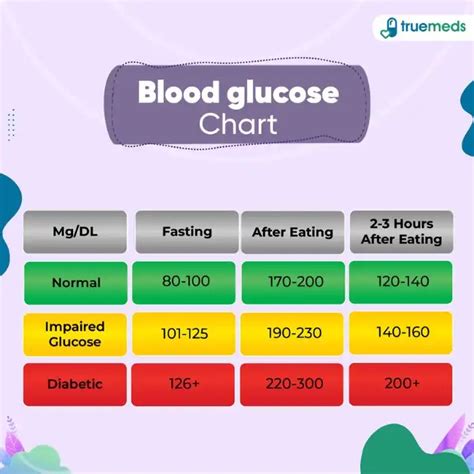Intro
Learn 5 tips to achieve normal blood glucose levels, managing diabetes through healthy habits, balanced diet, and regular monitoring, to maintain stable blood sugar and overall wellness.
Maintaining normal blood glucose levels is crucial for overall health, as it helps prevent the onset of various health issues, including diabetes, heart disease, and stroke. Normal blood glucose levels are typically between 70 and 140 milligrams per deciliter (mg/dL) after eating, and below 100 mg/dL when fasting. Achieving and maintaining normal blood glucose levels requires a combination of a healthy diet, regular physical activity, and stress management. In this article, we will delve into the importance of maintaining normal blood glucose levels and provide five tips to help you achieve this goal.
The importance of maintaining normal blood glucose levels cannot be overstated. When blood glucose levels are too high, the body's cells are unable to effectively use insulin, a hormone produced by the pancreas that helps regulate blood sugar levels. This can lead to a range of health problems, including insulin resistance, type 2 diabetes, and cardiovascular disease. On the other hand, when blood glucose levels are too low, the body's cells are not receiving the energy they need to function properly, which can lead to symptoms such as dizziness, confusion, and even loss of consciousness. By maintaining normal blood glucose levels, you can reduce your risk of developing these health problems and ensure that your body is functioning at its best.
Maintaining normal blood glucose levels also has a range of other benefits, including improved energy levels, better concentration and mental clarity, and a reduced risk of certain types of cancer. Additionally, when blood glucose levels are within a healthy range, the body is able to function more efficiently, which can lead to improved overall health and wellbeing. With the increasing prevalence of diabetes and other health problems related to blood glucose levels, it is more important than ever to take steps to maintain normal blood glucose levels. By following the five tips outlined in this article, you can take control of your blood glucose levels and reduce your risk of developing related health problems.
Understanding Blood Glucose Levels

Factors That Affect Blood Glucose Levels
Several factors can affect blood glucose levels, including diet, physical activity, stress, and certain medications. For example, consuming high amounts of sugar and refined carbohydrates can cause blood glucose levels to spike, while regular physical activity can help lower blood glucose levels. Stress can also affect blood glucose levels, as it can cause the body to produce more cortisol, a hormone that raises blood sugar levels. Certain medications, such as steroids and certain psychiatric medications, can also affect blood glucose levels.Tips for Maintaining Normal Blood Glucose Levels

Additional Tips for Maintaining Normal Blood Glucose Levels
In addition to the tips outlined above, there are several other strategies that can help maintain normal blood glucose levels. These include: * Monitoring blood glucose levels regularly to track progress and make adjustments as needed. * Working with a healthcare provider to develop a personalized plan for maintaining normal blood glucose levels. * Avoiding sugary drinks and foods that are high in added sugars, salt, and unhealthy fats. * Incorporating physical activity into daily routines, such as taking the stairs instead of the elevator or walking to work. * Getting enough vitamin D, as low levels of vitamin D have been linked to an increased risk of developing type 2 diabetes.The Importance of Regular Physical Activity

Types of Physical Activity That Can Help Maintain Normal Blood Glucose Levels
There are several types of physical activity that can help maintain normal blood glucose levels, including: * Aerobic exercise, such as walking, jogging, cycling, or swimming, which helps to improve cardiovascular health and increase insulin sensitivity. * Resistance training, such as weightlifting or bodyweight exercises, which helps to build muscle mass and improve insulin sensitivity. * High-intensity interval training (HIIT), which involves short bursts of high-intensity exercise followed by brief periods of rest, and can help to improve insulin sensitivity and cardiovascular health. * Yoga and Pilates, which can help to improve flexibility, balance, and overall physical fitness, and can also help to reduce stress and improve mental health and wellbeing.The Role of Diet in Maintaining Normal Blood Glucose Levels

Foods That Can Help Maintain Normal Blood Glucose Levels
There are several foods that can help maintain normal blood glucose levels, including: * Leafy green vegetables, such as spinach and kale, which are rich in fiber and antioxidants and can help to regulate blood glucose levels. * Berries, such as blueberries and strawberries, which are rich in fiber and antioxidants and can help to improve insulin sensitivity. * Fatty fish, such as salmon and tuna, which are rich in omega-3 fatty acids and can help to improve cardiovascular health and reduce inflammation. * Sweet potatoes, which are rich in fiber and antioxidants and can help to regulate blood glucose levels. * Legumes, such as lentils and chickpeas, which are rich in fiber and protein and can help to regulate blood glucose levels and improve insulin sensitivity.Stress Management and Blood Glucose Levels

Stress-Reducing Techniques That Can Help Maintain Normal Blood Glucose Levels
In addition to the stress-reducing techniques outlined above, there are several other strategies that can help manage stress and maintain normal blood glucose levels, including: * Getting enough sleep each night, as lack of sleep can exacerbate stress and disrupt blood glucose levels. * Engaging in regular physical activity, which can help to reduce stress and improve insulin sensitivity. * Practicing mindfulness, which involves being present in the moment and focusing on the breath, and can help to reduce stress and improve mental health and wellbeing. * Connecting with friends and family, which can help to reduce stress and improve overall mental health and wellbeing.Conclusion and Next Steps

We encourage you to share your thoughts and experiences with maintaining normal blood glucose levels in the comments section below. Have you found any particular strategies or techniques to be helpful in managing your blood glucose levels? Do you have any questions or concerns about maintaining normal blood glucose levels? Share your story and help others who may be struggling with similar issues.
What are normal blood glucose levels?
+Normal blood glucose levels are typically between 70 and 140 milligrams per deciliter (mg/dL) after eating, and below 100 mg/dL when fasting.
How can I maintain normal blood glucose levels?
+Maintaining normal blood glucose levels requires a combination of a healthy diet, regular physical activity, stress management, and getting enough sleep. It is also essential to work with a healthcare provider to develop a personalized plan for maintaining normal blood glucose levels.
What are the risks of high blood glucose levels?
+High blood glucose levels can increase the risk of developing insulin resistance, type 2 diabetes, cardiovascular disease, and certain types of cancer. It can also lead to symptoms such as fatigue, blurred vision, and increased thirst and urination.
How often should I check my blood glucose levels?
+The frequency of checking blood glucose levels depends on individual needs and health status. It is essential to work with a healthcare provider to determine the best schedule for checking blood glucose levels.
Can I maintain normal blood glucose levels without medication?
+Yes, it is possible to maintain normal blood glucose levels without medication by following a healthy diet, engaging in regular physical activity, practicing stress-reducing techniques, getting enough sleep, and staying hydrated. However, it is essential to work with a healthcare provider to develop a personalized plan for maintaining normal blood glucose levels.
